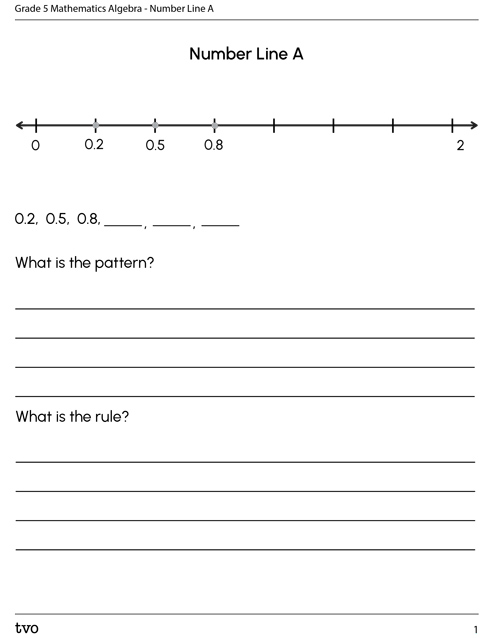Minds On
Representing numbers
Consider two possible representations of 2.41 using base 10 blocks. Can you think of other ways to represent 2.41?
What do you notice?
Number strings
A number string is a sequence of computations (+, —, ×, ÷) that highlights a pattern.
We can use number strings to show the relationship between hundredths and tenths and whole numbers.
Let’s re-examine 2.41 using a number string.
2.41 = 2 + 0.4 + 0.01
or
2 + 4 tenths + 1 hundredth
2.41 = 2 + 0.3 + 0.11
or
2 + 3 tenths + 11 hundredths
2.41 = 2 + 0.2 + 0.21
or
2 + 2 tenths + 21 hundredths
2.41 = 2 + 0.1 + 0.31
or
2 + 1 tenth + 31 hundredths
2.41 = 2 + 0.41
or
2 + 0 tenths + 41 hundredths
We could also break down the 2 wholes into tenths and hundredths, for example:


Our number string helps us to see that we can think of ones, tenths, and hundredths flexibly.
Action
Whole numbers and decimals
What other patterns can we explore with whole numbers and decimals?
Consider the following Number Line. Skip count by 3s, starting at 0.
Now try skip counting by 3 tenths, starting at 0.
What do you notice? What do you wonder? Will the pattern hold true for skip counting by 3 hundredths?
We can use these relationships to help us extend patterns that may include whole numbers and decimals.
For example, a pattern starts at 3, and increases by 2 tenths each time. What would the first 5 terms be?

Press ‘Reveal’ to check your answer.
Did you move to 3, 3.2, 3.4, 3.6, 3.8? Then, that’s correct!
What about shrinking patterns?
Complete the following pattern.
14.29, 14.28, 14.27, 14.26, (Blank), (Blank), (Blank).

What would the 10th term look like? The 11th?
Press ‘Reveal’ to check your answer.
Did you decompose the tenths into hundredths to find the values of 14.19 and 14.18?
Your Turn
You may complete “Number Line Patterns” in your notebook or using the following fillable and printable document.
a) 0.2, 0.5, 0.8, (Blank), (Blank), (Blank).

What is the pattern? What is the pattern rule?
Press ‘Reveal’ to check your answer.
The pattern is: 1.1, 1.4, 1.7
Rule: Start at 0.2 and add 0.3.
b) 6.87, 6.84, 6.81, 6.78, (Blank), (Blank), (Blank).

Press ‘Reveal’ to check your answer.
The pattern is: 6.75, 6.72, 6.69
Rule: Start at 6.87 and subtract 0.03.
c) 21.07, 21.11, 21.15, (Blank), (Blank), (Blank).

What is the pattern? What is the rule?
Press ‘Reveal’ to check your answer.
The pattern is: 21.11, 21.15, 21.19
Rule: Start at 21.07 and add 0.04.
Consolidation
Create a pattern

Choose a decimal number to hundredths (it may have a whole number.) Represent it in a variety of ways.
Create a growing or shrinking pattern starting at your number.
Explain how being able to move between hundredths, tenths, and ones helped you with your pattern.
Record your answers using a voice recorder, speech-to-text, or writing tool.
Reflection
As you read through these descriptions, which sentence best describes how you are feeling about your understanding of this learning activity? Press the button that is beside this sentence.
I feel...
Now, record your ideas using a voice recorder, speech-to-text, or writing tool.
Connect with a TVO Mathify tutor
Think of TVO Mathify as your own personalized math coach, here to support your learning at home. Press ‘TVO Mathify’ to connect with an Ontario Certified Teacher math tutor of your choice. You will need a TVO Mathify login to access this resource.
TVO Mathify (Opens in a new tab)

